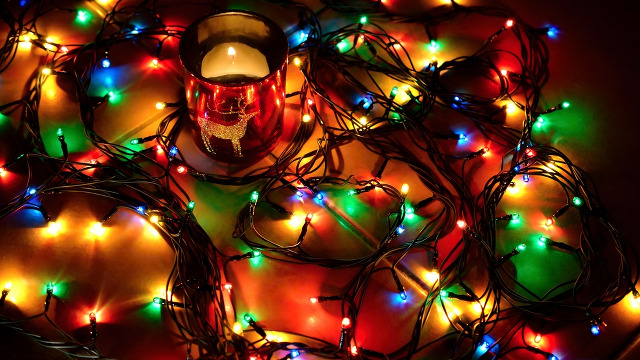SUMMARY
This is AI generated summarization, which may have errors. For context, always refer to the full article.

MANILA, Philippines – Homeowners gearing up to decorate their houses for Christmas should mind their purchases – it could turn out to be toxic.
The EcoWaste Coalition said they found 16 samples of Christmas lights containing alarming amounts of lead, a highly toxic chemical that could lead to serious health impacts, being sold in stores in Metro Manila.
The 16 sets of holiday strands had lead levels between 2,689 parts per million (ppm) to 32,500 ppm, way above the limit of 1,000 ppm under the European Union Directive on Restriction of Hazardous Substances (RoHS).
The EcoWaste Coalition said they bought these toxic Christmas lights from stores in Divisoria, Manila City and Monumento, Caloocan City from October 25 to 27. Each set of lights is priced from P50 to P220. The group used a handheld X-Ray Fluorescence (XRF) spectrometer to analyze lead content.
According to the World Health Organization (WHO), “lead exposure harms children at much lower doses, and the health effects are generally irreversible and can have a lifelong impact.”
Lead exposure through ingestion, inhalation or dermal contact can lead to mental retardation, growth delays, anemia, hearing loss and kidney injury, according to toxicologist Bessie Antonio.
The 10 samples with the highest lead levels are:
- “Decor Lights” with green wire and red, yellow and green LED bulbs and angel-like hanging ornaments on a rectangular brown and yellow box (32,500 ppm)
- “Seven Star” Christmas lights with black wire and white bulbs on a blue box with image of Snowman (9,830 ppm)
- “Merry Lights” with green wire and bulbs on a plastic bag (8,664 ppm)
- “J.F.” Christmas lights with green wire and red bulbs on a plastic bag (7,677 ppm)
- Lighting chains of big blue, green, red and yellow stars with white wire on a plastic bag (6,735 ppm)
- Unlabeled Christmas lights with green wire and orange bulbs on a white box marked “UL Listed” (5,782 ppm)
- “Multi Function” rice lights with clear wire on a blue box with image of a Christmas tree (4,751 ppm)
- “Millennium Lights” with green wire and red bulbs on a plastic bag (4,744 ppm)
- “JF Star” Christmas lights with green wire and clear bulbs on a plastic bag (4,621 ppm)
- “Mabuhay Star” Christmas lights by Wan Da Xin Trading International, Inc. with green wire and clear bulbs on a plastic bag (4,187 ppm)
The EU Directive on Restriction of Hazardous Substances (RoHS) is one major international restriction flouted by the toxic Christmas lights that have found their way to Metro Manila stores.
The RoHS restricts the use of 6 hazardous materials in electrical and electronic products. These are the heavy metals cadmium, hexavalent chromium, lead and mercury; and flame retardant chemicals polybrominated biphenyls and polybrominated diphenyl ethers.
RoHS compliance is important because the 6 substances “are hazardous to the environment and pollute landfills, and are dangerous in terms of occupational exposure during manufacturing and recycling,” according to the RoHS Guide.
Toxic dumping
And yet products with these dangerous substances continue to be sold to Filipino shoppers.
“We are worried that cheap, lead-containing imported holiday lights that could not enter the EU market are being dumped here,” said Thony Dizon, Coordinator of the EcoWaste Coalition’s Project Protect.
“It’s obvious that manufacturers of poor quality lighting chains and other electrical and electronic products are profiting from our lack of a RoHS-like policy at the expense of our people’s health and safety.”
Discarded and broken Christmas lights loaded with toxics can add to the growing amount of hazardous garbage that end up in our landfills. Once there, they contaminate groundwater or underground water held by soil that is often used as drinking water by communities. Waste collectors and recyclers also become exposed to the dangers of these toxic pollutants.
The Christmas lights also violate Philippine product standards.
The samples of Christmas lights did not have complete product, chemical, energy and safety labeling information, and many did not bear the required Import Commodity Compliance Certificate (ICC) holographic sticker for imported lights. Many did not have the Philippine Standard mark for locally manufactured lights.
And it’s not just Christmas lights flouting the regulations. Toxic toys were also found being sold in Manila and Parañaque stores.
With the holiday season in full swing in a matter of weeks, consumers are warned to stay away from substandard Christmas lights aside from toxic ones. Poor-quality lights pose a risk of burns, electric shock, fire and chemical exposure.
The EcoWaste Coalition has notified the Department of Trade and Industry through the Bureau of Trade and Consumer Protection about its findings. They’ve also asked the government agency to validate the authenticity of the ICC stickers in some of the samples. – Rappler.com
Christmas lights image from Shutterstock
Add a comment
How does this make you feel?
There are no comments yet. Add your comment to start the conversation.